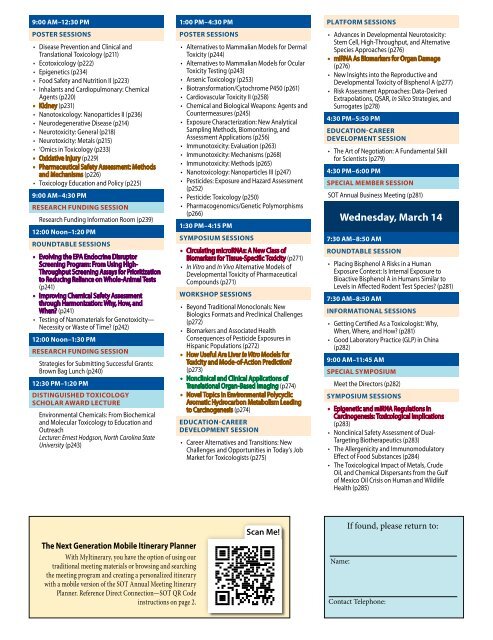Annual Meeting Program - Society of Toxicology
Annual Meeting Program - Society of Toxicology
Annual Meeting Program - Society of Toxicology
You also want an ePaper? Increase the reach of your titles
YUMPU automatically turns print PDFs into web optimized ePapers that Google loves.
9:00 AM–12:30 PM<br />
Poster SessionS<br />
• Disease Prevention and Clinical and<br />
Translational <strong>Toxicology</strong> (p211)<br />
• Ecotoxicology (p222)<br />
• Epigenetics (p234)<br />
• Food Safety and Nutrition II (p223)<br />
• Inhalants and Cardiopulmonary: Chemical<br />
Agents (p220)<br />
• Kidney (p231)<br />
• Nanotoxicology: Nanoparticles II (p236)<br />
• Neurodegenerative Disease (p214)<br />
• Neurotoxicity: General (p218)<br />
• Neurotoxicity: Metals (p215)<br />
• ‘Omics in <strong>Toxicology</strong> (p233)<br />
• Oxidative Injury (p229)<br />
• Pharmaceutical Safety Assessment: Methods<br />
and Mechanisms (p226)<br />
• <strong>Toxicology</strong> Education and Policy (p225)<br />
9:00 AM–4:30 PM<br />
Research Funding Session<br />
Research Funding Information Room (p239)<br />
12:00 Noon–1:20 PM<br />
Roundtable Sessions<br />
• Evolving the EPA Endocrine Disruptor<br />
Screening <strong>Program</strong>: From Using High-<br />
Throughput Screening Assays for Prioritization<br />
to Reducing Reliance on Whole-Animal Tests<br />
(p241)<br />
• Improving Chemical Safety Assessment<br />
through Harmonization: Why, How, and<br />
When? (p241)<br />
• Testing <strong>of</strong> Nanomaterials for Genotoxicity—<br />
Necessity or Waste <strong>of</strong> Time? (p242)<br />
12:00 Noon–1:30 PM<br />
Research Funding Session<br />
Strategies for Submitting Successful Grants:<br />
Brown Bag Lunch (p240)<br />
12:30 PM–1:20 PM<br />
Distinguished <strong>Toxicology</strong><br />
Scholar Award Lecture<br />
Environmental Chemicals: From Biochemical<br />
and Molecular <strong>Toxicology</strong> to Education and<br />
Outreach<br />
Lecturer: Ernest Hodgson, North Carolina State<br />
University (p243)<br />
1:00 PM–4:30 PM<br />
Poster Sessions<br />
• Alternatives to Mammalian Models for Dermal<br />
Toxicity (p244)<br />
• Alternatives to Mammalian Models for Ocular<br />
Toxicity Testing (p243)<br />
• Arsenic <strong>Toxicology</strong> (p253)<br />
• Biotransformation/Cytochrome P450 (p261)<br />
• Cardiovascular Toxicity II (p258)<br />
• Chemical and Biological Weapons: Agents and<br />
Countermeasures (p245)<br />
• Exposure Characterization: New Analytical<br />
Sampling Methods, Biomonitoring, and<br />
Assessment Applications (p256)<br />
• Immunotoxicity: Evaluation (p263)<br />
• Immunotoxicity: Mechanisms (p268)<br />
• Immunotoxicity: Methods (p265)<br />
• Nanotoxicology: Nanoparticles III (p247)<br />
• Pesticides: Exposure and Hazard Assessment<br />
(p252)<br />
• Pesticide: <strong>Toxicology</strong> (p250)<br />
• Pharmacogenomics/Genetic Polymorphisms<br />
(p266)<br />
1:30 PM–4:15 PM<br />
Symposium Sessions<br />
• Circulating microRNAs: A New Class <strong>of</strong><br />
Biomarkers for Tissue-Specific Toxicity (p271)<br />
• In Vitro and In Vivo Alternative Models <strong>of</strong><br />
Developmental Toxicity <strong>of</strong> Pharmaceutical<br />
Compounds (p271)<br />
Workshop Sessions<br />
• Beyond Traditional Monoclonals: New<br />
Biologics Formats and Preclinical Challenges<br />
(p272)<br />
• Biomarkers and Associated Health<br />
Consequences <strong>of</strong> Pesticide Exposures in<br />
Hispanic Populations (p272)<br />
• How Useful Are Liver In Vitro Models for<br />
Toxicity and Mode-<strong>of</strong>-Action Prediction?<br />
(p273)<br />
• Nonclinical and Clinical Applications <strong>of</strong><br />
Translational Organ-Based Imaging (p274)<br />
• Novel Topics in Environmental Polycyclic<br />
Aromatic Hydrocarbon Metabolism Leading<br />
to Carcinogenesis (p274)<br />
Education-Career<br />
Development Session<br />
• Career Alternatives and Transitions: New<br />
Challenges and Opportunities in Today’s Job<br />
Market for Toxicologists (p275)<br />
Platform Sessions<br />
• Advances in Developmental Neurotoxicity:<br />
Stem Cell, High-Throughput, and Alternative<br />
Species Approaches (p276)<br />
• miRNA As Biomarkers for Organ Damage<br />
(p276)<br />
• New Insights into the Reproductive and<br />
Developmental Toxicity <strong>of</strong> Bisphenol A (p277)<br />
• Risk Assessment Approaches: Data-Derived<br />
Extrapolations, QSAR, In Silico Strategies, and<br />
Surrogates (p278)<br />
4:30 PM–5:50 PM<br />
Education-Career<br />
Development Session<br />
• The Art <strong>of</strong> Negotiation: A Fundamental Skill<br />
for Scientists (p279)<br />
4:30 PM–6:00 PM<br />
Special Member session<br />
SOT <strong>Annual</strong> Business <strong>Meeting</strong> (p281)<br />
Wednesday, March 14<br />
7:30 AM–8:50 AM<br />
Roundtable Session<br />
• Placing Bisphenol A Risks in a Human<br />
Exposure Context: Is Internal Exposure to<br />
Bioactive Bisphenol A in Humans Similar to<br />
Levels in Affected Rodent Test Species? (p281)<br />
7:30 AM–8:50 AM<br />
Informational Sessions<br />
• Getting Certified As a Toxicologist: Why,<br />
When, Where, and How? (p281)<br />
• Good Laboratory Practice (GLP) in China<br />
(p282)<br />
9:00 AM–11:45 AM<br />
SPECIAL SYMPOSIUM<br />
Meet the Directors (p282)<br />
Symposium Sessions<br />
• Epigenetic and miRNA Regulations in<br />
Carcinogenesis: Toxicological Implications<br />
(p283)<br />
• Nonclinical Safety Assessment <strong>of</strong> Dual-<br />
Targeting Biotherapeutics (p283)<br />
• The Allergenicity and Immunomodulatory<br />
Effect <strong>of</strong> Food Substances (p284)<br />
• The Toxicological Impact <strong>of</strong> Metals, Crude<br />
Oil, and Chemical Dispersants from the Gulf<br />
<strong>of</strong> Mexico Oil Crisis on Human and Wildlife<br />
Health (p285)<br />
The Next Generation Mobile Itinerary Planner<br />
With MyItinerary, you have the option <strong>of</strong> using our<br />
traditional meeting materials or browsing and searching<br />
the meeting program and creating a personalized itinerary<br />
with a mobile version <strong>of</strong> the SOT <strong>Annual</strong> <strong>Meeting</strong> Itinerary<br />
Planner. Reference Direct Connection—SOT QR Code<br />
instructions on page 2.<br />
Scan Me!<br />
Name:<br />
If found, please return to:<br />
Contact Telephone:
















